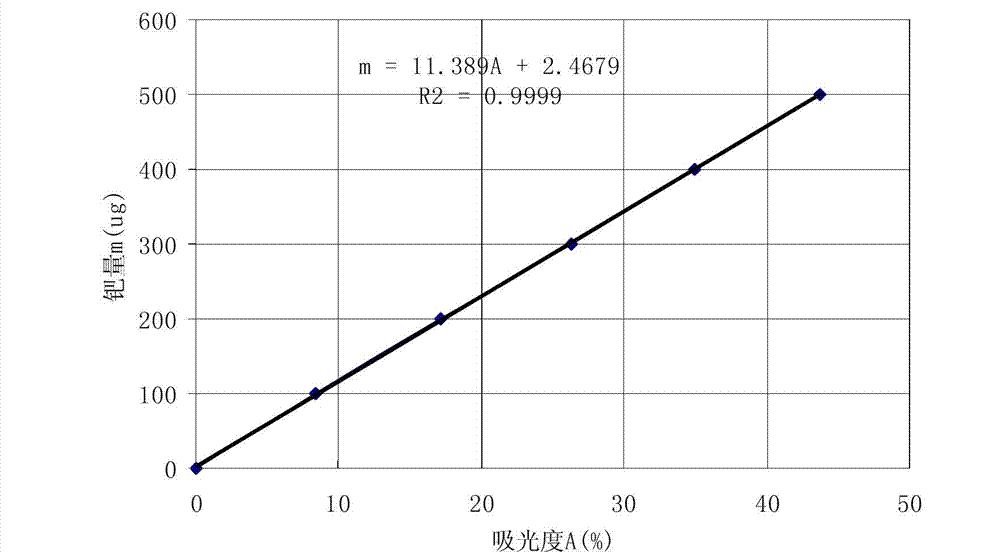Palladium content testing method
A detection method and content technology, applied in the field of spectral analysis, can solve the problems that affect the accuracy of the measurement results, many separation steps, and complicated processes, and achieve the effects of small impact, reduced pollution, and simple process
- Summary
- Abstract
- Description
- Claims
- Application Information
AI Technical Summary
Problems solved by technology
Method used
Image
Examples
Embodiment 1
[0027] Palladium standard curve production:
[0028] Palladium standard solution (100mg / L)
[0029] Use a graduated pipette to pipette 0, 1.00, 2.00, 3.00, 4.00, 5.00mL of the palladium standard solution into six 25ml volumetric flasks, slowly add 1.0ml of stannous chloride solution with a concentration of 0.5mol / L and lightly Shake gently, dilute to the mark with (1+6) hydrochloric acid, shake well, let stand for 15 minutes, measure the absorbance A of the test solution at a wavelength of 635nm with a 1cm cuvette.
[0030] Measure the absorbance A at a wavelength of 635nm with a 1cm cuvette and the reagent blank as the reference solution. Take the amount of palladium (in μg) as the ordinate, and the corresponding absorbance value A (in %) as the abscissa, draw a standard curve, and calculate the slope k and intercept b of the standard curve regression equation.
Embodiment 2
[0032] Palladium content detection
[0033] Measuring range: palladium content 0-500μg; if the content of the actual detection object is high, it can be diluted by proportional dilution method for detection.
[0034] Tin protochloride solution configuration (0.5mol / L): take by weighing 11.3g tin protochloride (SnCl 2 2H 2 O), the added concentration is (1+6) hydrochloric acid solution 100ml is dissolved and prepared.
[0035] Accurately weigh and dissolve the substance to be tested, pipette the same volume of test solution and blank solution into two 25ml volumetric flasks, and add 5ml of hydrochloric acid with a concentration of (1+6) at the same time, shake well, then slowly add 1.0ml of hydrochloric acid with a concentration of 0.5mol / L tin protochloride solution and shake gently at the same time, dilute to the mark with hydrochloric acid with a concentration of (1+6), shake well and set aside; the above-mentioned solution to be tested is left for 15 minutes, with a 1cm c...
Embodiment 3
[0038] Specific detection example
[0039] Test sample content: 430 μg, containing platinum and rhodium interferers.
[0040] The absorbance measured by two parallel samples is as follows: Table 1
[0041] sample number
Sample 1
Sample 2
Absorbance A(%)
36.92
36.55
Sample determination content (μg)
422.9
418.7
Relative error(%)
-1.65
2.63
[0042] Table 1 shows that the measurement error meets the requirements.
[0043] Standard curve determination data: Table 2
[0044] Palladium content (ug)
Absorbance A(%)
0
0
100
8.34
200
17.18
300
26.28
400
34.92
500
43.69
[0045] To make a standard curve: such as figure 1 , the slope of the standard curve regression equation k=11.389: intercept; b=2.4679.
[0046] Standard curve: m=11.389A+2.4679
[0047] The linear correlation coefficient R satisfies R 2 =0.9999, indicating t...
PUM
 Login to View More
Login to View More Abstract
Description
Claims
Application Information
 Login to View More
Login to View More - R&D
- Intellectual Property
- Life Sciences
- Materials
- Tech Scout
- Unparalleled Data Quality
- Higher Quality Content
- 60% Fewer Hallucinations
Browse by: Latest US Patents, China's latest patents, Technical Efficacy Thesaurus, Application Domain, Technology Topic, Popular Technical Reports.
© 2025 PatSnap. All rights reserved.Legal|Privacy policy|Modern Slavery Act Transparency Statement|Sitemap|About US| Contact US: help@patsnap.com

